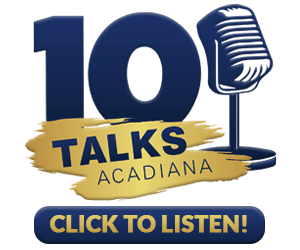THIBODAUX, La. – As the nation continues to debate the place of Confederate flags and monuments in public spaces, the president of a university bearing the name of a Confederate general is considering the question himself.
“I don’t have a set plan of action, but I’ve been thinking about it. Obviously, we don’t want to pretend. … You don’t want to say nothing happened,” Nicholls State University President Bruce Murphy said in an interview Monday. “It is in our journals that we look at, the Chronicle of Higher Education and Inside Higher Education and those kinds of things; they’re discussing these sorts of things.”
The Thibodaux university, founded in 1948, honors Francis T. Nicholls, and two campus buildings, Beauregard and Polk halls, reference Confederate generals.
Amid the national debate, Murphy said his administration is examining the school’s policy for naming buildings, and he plans to approach the issue with faculty and students.
“We’re not in the businesses of stirring up the hornet’s nest, but at the same time we have to be sensitive to these things,” he said.
Murphy said the situation could unfold similar to when the school’s former mascot, a gray-clad soldier with a thick white beard, was dropped in 2004 amid concerns it represented the Old South and the Confederacy. A new mascot was unveiled five years later.
But so far, no one has questioned the names, he said.
Whether that stems from the few students on campus during summer, disinterest in the topic or a lack of knowledge about the buildings’ namesakes is hard to tell.
The book “Nicholls State University: The Elkins-Galliano Years, 1948-1983,” by retired professor Alfred Delahaye, says Beauregard and Polk halls’ names were approved in 1961 by the state board that governs the school. The names were recommended by Nicholls’ then-president, Charles Elkins.
Elkins, Delahaye wrote, was influenced by Charles Perilloux, the state supervisor of college plants, who recommended naming buildings after Francis T. Nicholls’ contemporaries who were also involved in state affairs.
The then science building would bear the name of Pierre Gustave Toutant Beauregard, a St. Bernard Parish native who ordered the bombardment of Fort Sumter. After a prominent career as a brigadier general for the Confederacy, he promoted the Louisiana Lottery Company, one of the most corrupt systems of its time.
The soon-to-be completed library would be named for Leonidas Polk. Originally from North Carolina, he was the first Episcopal bishop of Louisiana, operated Leighton Plantation near Thibodaux and died during battle as a lieutenant general in the Confederate Army.
To Perilloux, Beauregard was “undoubtedly one of the greatest engineers and scientists identified with the Confederate Army,” while Polk was “the outstanding man of letters connected with the Confederate Army.”
Officials who chose the names came from a social class with a specific view of history, said Paul Leslie, who taught history at Nicholls for 40 years.
In addition to commemorating the Civil War’s centennial, using names of prominent generals might have been used to steer Nicholls away from a provincial status, he said.
” ‘Beauregard Hall’ — you don’t think of Thibodaux,” he said.
Unlike the other two generals, Francis T. Nicholls, was known as a reluctant soldier who lost an arm and foot in the war, said Leslie, who completed extensive research his life.
“He always said, don’t look upon me as a war hero. Don’t look at me as a willing participant in that war,” Leslie said. “He said, every battle I fought, I lost a limb. But, he says, I’ll give what’s left of me to the state of Louisiana.”
A native of Donaldsonville, Nicholls returned to south Louisiana after the war and served two terms as governor and later served as chief justice of the state Supreme Court.
“If you look at his background he was probably one of the most genuine individuals who believed in democracy,” Leslie said.
For many historians, judging the individuals whose names are on buildings is tricky by today’s standards.
“History is fickle. It changes all the time, and one man’s hero may be another man’s villain,” Leslie said. “To go back and hunt throughout history to go through this purge, I mean, where do you stop?”
Paul Wilson, associate professor of history at Nicholls, pointed to Franklin Roosevelt, who approved Japanese internment during World War II.
“Do we remember him as this awful, evil racist because he did that? I don’t think so,” he said. “It was unjust. We can look back on it and see how unjust it was, but something that occurred in the context of a brutal global war.”
For retired Nicholls history professor John Dennis, the monuments, like the ones New Orleans Mayor Mitch Landrieu has called to remove, are about remembrance.
“Being a historian, my attitude is that we are not supposed to forget the past. To me that’s what the monuments do, they cause people to recall the past, good and bad. You can’t just paint the good side of it; you’ve got to have the bad side too.”
The same historians argue the Confederate flag should be removed from public buildings.
Lafourche Parish NAACP President Burnell Tolbert said lowering the flag and taking down monuments will not change people’s hearts and minds, but it is a gesture of goodwill.
“It’s not really going to strop racism, but it’s a step forward,” he said.
On campus Monday, incoming freshmen Lexcie Lewis and Morgan Thibodaux held differing opinions about the flag, but both agreed on how frequently the name of the building crosses their minds.
“Never,” they said.
Murphy said university leaders will try to determine if the school’s overall message is one of inclusivity and support, without being reactive.
“We will try to proceed doing the best thing for our students first of all, and our community and everybody else,” he said. “The last thing we want to do is to have anything that is offensive or, like I said before, makes people feel uncomfortable.”
